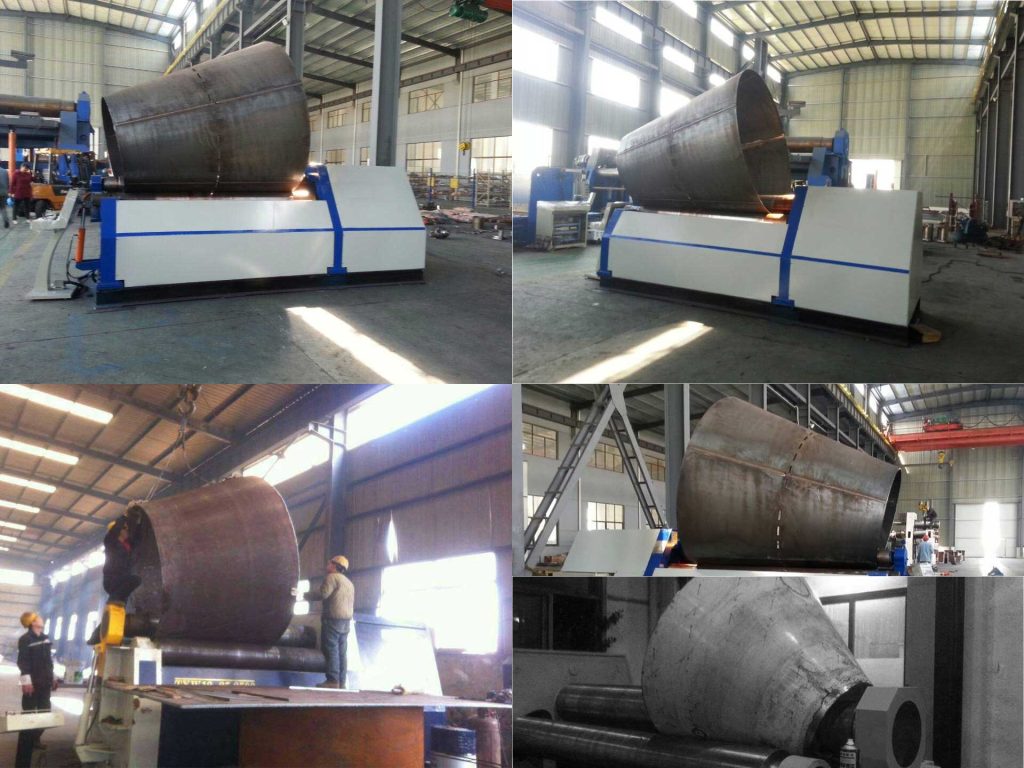What is Plate Rolling?
Plate rolling is a fabricating process that is used to form various types of sheet metal, mainly stainless, aluminum, and steel into circular, conical, round, or any other shapes.
Plate rolling machines (aka “plate rollers” or “roll bending machines”) give materials their shape by using force through their rollers that are powered by mechanical, hydraulic, or
electrical systems. A plate rolling machine selection is made based on the rolling capacity needed. In a recent article titled Your Guide to Determining the Plate Rolling
The capacity of Your Plate Roll more details can be found on plate rolling capacity.
UNBENT FLAT IN ROLL BENDING
Plate rolls need a place to grab the material during forming. That’s why, in any plate rolling situation, you have a narrow unbent flat section on the plate’s leading and trailing edges.
Choosing a plate rolling machine that matches the required roll geometry and thickness minimizes the flat portions at the beginning and end of the rolled sections. The rolls grab the lead-in plate edge and, once the plate is in the correct position, commence pre-bending to minimize the flat portion at the start of the roll. This operation takes considerably more power than rolling; typically a machine that can roll a 1.25-in. plate may only have enough power to prebend 1-in. plate.
To prebend, rolls act like a press brake in reverse. The bottom rolls rise, pushing the plate against the top roll to create the initial bend. After rolling, the rolls do the same thing at the plate’s trailing edge. The problem is that during each bending operation, the rolls must hold onto the plate somewhere, and these pinch points happen to be at the very leading and trailing edges of the rolled plate.
These edges remain flat, and the only way to eliminate them entirely is to reroll the section after welding or cut off the flat section, both of which hamper productivity. Rerolling also demands serious power from the rolling machine. For this reason, the best approach usually is to purchase a rolling machine that leaves a minimal amount of flat and can produce products that meet quality standards without rerolling.
What is Pre-Bending in Plate Rolling?
Pre-bending refers to the process of holding sheet metal firmly between multiple rolls and pushing it in order to create the initial bend. With the rotation of the rolls on the
plate rolling machine, the material is fed through the rolls and once the 360-degree rolling process is completed, the pre-bent end of the material makes it very easy to
connect the 2 ends, thanks to the pre-bending process.
HOW TO CHOOSE THE RIGHT BENDING ROLLS?
As always, the application dictates which machine is best. Consider a four-roll machine designed for a 1-in. plate. The machine will produce flat sections that are 1.5 to 2 times the material thickness. This means there will be 2 in. of flat on a cylinder of the 1-in.-thick plate, which is acceptable for most applications.
However, if the next job happens to be for a 0.25-in. plate, issues can arise with a fixed-geometry system. Its lower rolls can be adjusted only up and down, not side to side, so it still produces a 2-in.-wide flat section at the end of the rolled section. That’s eight times the material thickness on 0.25-in. material, which typically isn’t acceptable at all. In this case, a variable-geometry system would fit the bill, because it allows operators to position the lower rolls wherever needed to maintain the minimum width of flat at the leading and trailing edges of the rolled section for a wide range of material thicknesses.
From the original design principle of the machine: the pre-bending function of the CNC 4-roll plate bending machine, the 3-roll variable geometry plate bending machine, and the top roll variable geometry 3-roll bending machine has minimized possible the unbend flat in the workpiece.
4 Reasons Pre-Bending is Crucial When Selecting a Plate
Roll
- Eliminates Waste Pre-bending process helps minimize waste by creating an optimum geometrical formation so that both ends of the material can get in touch after rolling as perfectly as
possible. Practicing the pre-bending process while having an experienced and skilled plate rolling machine operator plays a very critical role in eliminating waste. - Eliminates the Need for Extra TrimmingThe resources used on extra material trimming in plate rolling is nothing to be ignored
for any efficiently and effectively functioning fabrication shops or operations. The need
for extra trimming can easily be avoided through pre-bending by forming an optimum
alignment of both ends of sheet metal after rolling the material. - Saves TimeEspecially for high-volume production shops, wasting a minute out of the production
time means wasting money and it can add up real fast over time. Since pre-bending
helps an operator to form the desired shapes faster, the operating time per sheet metal
on a plate rolling machine diminishes, which means rolling more parts with less time. - Smooth Bending Surface and Uniform Curvature / ThicknessPre-bending process is one of the most important practices in plate rolling when it
comes to being able to get the results that were initially intended to get, which is simply
rolling the material correctly. Properly rolled material will inevitably result in smooth
material surface and uniformity in material curvature and thickness.
Works Cited
- Plate Rolling: What is ‘Pre-Bending’ and Why Is It So Important”, Bendmak USA, Visited 18 Aug, https://www.bendmakusa.com/blog/plate-rolling-pre-bending
- “ROLL BENDING BASICS: MINIMIZING THE UNBEND FLAT”, Angle Roll, Visited 18 Aug, https://www.angleroller.com/bending-of-plates/roll-bending-basics-minimizing-the-unbend-flat.html
